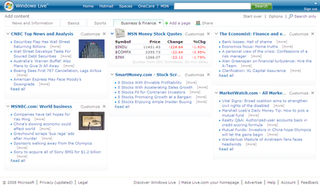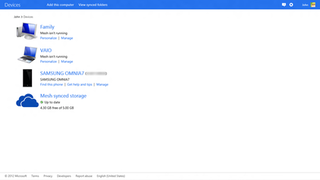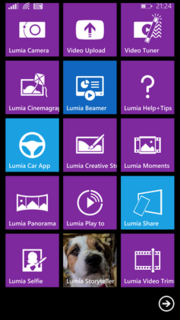
MSN is a web portal and related collection of Internet services and apps for Windows and mobile devices, provided by Microsoft and launched on August 24, 1995, the same release date as Windows 95.
Blogger is an American blog-publishing service that allows multi-user blogs with time-stamped entries. It was developed by Pyra Labs, which was bought by Google in 2003. The blogs are hosted by Google and generally accessed from a subdomain of blogspot.com. Blogs can also be served from a custom domain owned by the user by using DNS facilities to direct a domain to Google's servers. A user can have up to 100 blogs per account.

File Explorer, previously known as Windows Explorer, is a file manager application that is included with releases of the Microsoft Windows operating system from Windows 95 onwards. It provides a graphical user interface for accessing the file systems. It is also the component of the operating system that presents many user interface items on the screen such as the taskbar and desktop. Controlling the computer is possible without Windows Explorer running.

Microsoft Office 2007 is a version of Microsoft Office, a family of office suites and productivity software for Windows, developed and published by Microsoft. It was released to manufacturing on November 3, 2006; it was subsequently made available to volume license customers on November 30, 2006, and later to retail on January 30, 2007, the same respective release dates of Windows Vista. The ninth major release of Office for Windows, Office 2007 was preceded by Office 2003 and succeeded by Office 2010. The Mac OS X equivalent, Microsoft Office 2008 for Mac, was released on January 15, 2008.

Windows Media Center (WMC) is a discontinued digital video recorder and media player created by Microsoft. Media Center was first introduced to Windows in 2002 on Windows XP Media Center Edition (MCE). It was included in Home Premium and Ultimate editions of Windows Vista, as well as all editions of Windows 7 except Starter and Home Basic. It was also available on Windows 8 Pro and Windows 8.1 Pro as a paid add-on, before being discontinued in Windows 10, although it can reportedly be unofficially reinstalled using a series of Command Prompt commands.

Windows Live is a discontinued brand-name for a set of web services and software products from Microsoft as part of its software plus services platform. Chief components under the brand name included web services, several computer programs that interact with the services, and specialized web services for mobile devices.

Windows Live Personalized Experience was a customizable portal launched by Microsoft in early November 2005. It was one of the first Windows Live services to launch.
Microsoft Gadgets are lightweight single-purpose applications, or software widgets, that can sit on a Microsoft Windows user's computer desktop, or are hosted on a web page. According to Microsoft, it will be possible for the different types of gadgets to run on different environments without modification, but this is currently not the case.
Compared with previous versions of Microsoft Windows, there are numerous features new to Windows Vista, covering most aspects of the operating system, which include additional management features, new aspects of security and safety, new I/O technologies, new networking features, and new technical features.

Windows Photo Gallery is a discontinued image organizer, photo editor and photo sharing program. It is a part of Microsoft's Windows Essentials software suite. The product has been unavailable for download since January 10, 2017, as the Windows Essentials line of products have been discontinued.

Windows SideShow was a feature by Microsoft introduced in Windows Vista to supply information such as e-mail, instant messages, and RSS feeds from a personal computer to a local or remote peripheral device or display. SideShow was intended to enhance the Windows experience by enabling new mobility scenarios for the Windows platform and by providing power saving benefits as part of Microsoft's broader efforts regarding a mobile initiative.

Windows Live Mesh was a free-to-use Internet-based file synchronization application by Microsoft designed to allow files and folders between two or more computers to be in sync with each other on Windows and Mac OS X computers or the Web via SkyDrive. Windows Live Mesh also enabled remote desktop access via the Internet.

Windows Live Spaces was Microsoft's blogging platform and social network service. The site was originally released in early 2004 as MSN Spaces to compete with other social networking services, and re-launched in 2006 as a part of a shifting of community services away from the MSN brand. Windows Live Spaces received an estimated 27 million (27,000,000) unique visitors per month as of August 2007. Despite being considered a useful messaging and communication tool, Windows Live Spaces has been criticized as not being as powerful as some of its alternatives. It was shut down in 2011 due to low viewership.

Windows Live Alerts was a part of the Windows Live services from Microsoft that allowed users to get notification of time-sensitive events and information from various alert content providers. Users were able to choose how and when to receive alerts, so that users may stay informed no matter where they are.

Microsoft Office 2010 is a version of Microsoft Office for Microsoft Windows that was released to manufacturing on April 15, 2010 and was later made available to retail on June 15, 2010 as the successor to Office 2007 and the predecessor to Office 2013. The Mac OS X equivalent, Microsoft Office 2011 for Mac, was released on October 26, 2010.
Fotki is a digital photo sharing, video sharing and media social network website and web service suite; it is one of the world's largest social networking sites. In many ways, the site appears to be similar to the majority of other popular photo sites which support a number of so-called Web 2.0 features, such as use of Ajax, tagging, RSS feeds, social bookmarking, GPS location information and Exif info display.

MSN Messenger, later rebranded as Windows Live Messenger, was a cross-platform instant messaging client developed by Microsoft. It connected to the Microsoft Messenger service while also having compatibility with Yahoo! Messenger and Facebook Messenger. The client was first released as MSN Messenger Service on July 22, 1999, and was marketed under the MSN branding until 2005 when it was rebranded under Windows Live. It has since been officially known by its second name, although its first name was still used colloquially by most of its users. In June 2009, Microsoft reported the service attracted over 330 million active users each month, placing Messenger among the most widely used instant messaging clients in the world.
Some of the new features included in Windows 7 are advancements in touch, speech and handwriting recognition, support for virtual hard disks, support for additional file formats, improved performance on multi-core processors, improved boot performance, and kernel improvements.

Windows Live Devices was an online device management service as part of Windows Live which will allow users to centrally access and manage the synchronization of files stored on their computers, mobile devices, as well as other peripherals such as digital photo frames. Windows Live Devices also allows users to remotely access their computers from the internet using a web browser.

Lumia imaging apps are imaging applications by Microsoft Mobile and formerly by Nokia for Lumia devices built on the technology of Scalado. The Lumia imaging applications were notably all branded with "Nokia" in front of their names, but after Microsoft acquired Nokia's devices and services business the Nokia branding was superseded with "Lumia", and often updates included nothing but name changes, but for the Lumia Camera this included a new wide range of feature additions. Most of the imaging applications are developed by the Microsoft Lund division. As part of the release of Windows 10 Mobile and the integration of Lumia imaging features into the Windows Camera and Microsoft Photos applications some of these applications stopped working in October 2015.
















